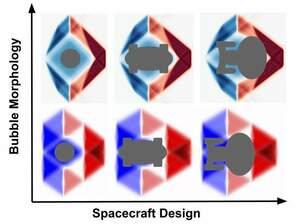 Astrophysicist at Göttingen University discovers new theoretical solutions for hyper-fast solitons
Astrophysicist at Göttingen University discovers new theoretical solutions for hyper-fast solitons
If travel to distant stars is to be possible within the lifetime of a human being, a propulsion system must be found that is faster than the speed of light. Previous research on faster-than-light transport based on Einstein's general theory of relativity requires huge amounts of hypothetical particles and states of matter that have "exotic" physical properties such as a negative energy density.
This kind of matter is currently either impossible to find or cannot be produced in usable quantities. A researcher at Göttingen University, on the other hand, is circumventing this problem: he is constructing a new class of hyperfast "solitons" from sources with only positive energy, which could enable travel at any speed. The results of the study have been published in the journal Classical and Quantum Gravity.
The paper's author, Dr Erik Lentz, analysed existing research and discovered gaps in previous studies on "warp drive". Lentz noted that there are unexplored configurations of space-time curvature that are organised into "solitons". These have the potential to solve the puzzle and are at the same time physically realisable. A soliton - also informally referred to as a warp bubble in this context - is a compact wave that maintains its shape and moves at a constant speed. Lentz derived Einstein's equations for unexplored soliton configurations in which the "shift vector" components of the space-time metric obey a hyperbolic relationship. In the process, he found that the modified space-time geometries can be formed in a way that also works with conventional energy sources.
Given enough energy, space travel to Proxima Centauri, our nearest star, and back to Earth could be possible on this basis within a few years instead of decades or millennia. A human could thus make the journey in the course of his or her lifetime. By comparison, with today's rocket technology, the simple journey would take more than 50,000 years.
Furthermore, the solitons have been configured to contain a region with minimal tidal forces, so that the passage of time inside the soliton is the same as outside: an ideal environment for a spacecraft. This means that there would not be the complications of the so-called "twin paradox", where one twin travelling close to the speed of light would age much more slowly than the other twin who stayed on Earth: in fact, according to the new equations, both twins would be the same age when reunited.
"This work has taken the problem of faster-than-light travel a step away from theoretical research in fundamental physics and closer to engineering," says Lentz. "The next step is to figure out how to bring the astronomical amount of energy needed into the realm of today's technologies, such as a large modern nuclear fission power plant. Then we could talk about building the first prototypes."
Currently, the energy required for this new type of space propulsion is still immense. Lentz explains, "The energy required for this propulsion at the speed of light for a spacecraft with a radius of 100 metres is of the order of a hundred times the mass of the planet Jupiter. The energy savings would have to be drastic, in the range of about 30 orders of magnitude, to come within the range of modern nuclear fission reactors. Fortunately, several energy-saving mechanisms have been proposed in previous research that could potentially reduce the required energy by nearly 60 orders of magnitude."
www.eriklentzphd.com


















































































